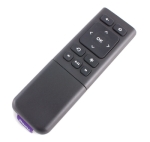Using Roku: Week 1
I’ve been using the Roku box for about a week now. At first I just saw it as a replacement for the Xbox 360’s streaming of Netflix. But there’s a lot more programming available via the Roku that I’m still exploring.

One of the things I’ve noticed is how simple the user interface is. As with iTunes, navigation is dependent on basic metadata about program and channel types for getting around. With no keyboard there is the occasional need for an onscreen punch-and-click keyboard, but that moves quite smoothly. I was impressed, for example, at how easy it was to link up with my own YouTube channel.
I really enjoy the well produced “tech” shows such as the ones produced by TWiT.tv. The give and take of This Week in Google, for example, is compelling whether viewed on TV or (in audio only) via podcast.In fact, I’ve even begun preferring such broadcasts over the plethora of text and image based “magazine” sites available via the web, despite my fondness for reading. There are three reasons for this preference, I think.
First, a good interview or “talking heads” show can provide insight and background from knowledgeable people that goes beyond the rush-to-publish ethos of standard website based reporting. I’m not so desperate for up-to-the-minute facts that I can’t afford to wait a few days for someone smart to thoughtfully put things into perspective. A good case in point: on therecent This Week in Google 77, Kevin Marks talked about the significance of Google’s recent decision to drop h.264.
Second, if you look at a typical tech news page on the web, especially one that has its heritage in the print magazine field, there’s usually a cacaphony of links, images, banner ads, and animations that distract from the content. Aesthetically, many pages are a mess and unpleasant to read — especially those silly articles that make you click 3 or 4 times to make it through the entire thing.
Third, the TV shows may have commercials but they usually don’t have the comment features that online news articles often have. As often as not these comment fields, even when they require registration and check-in, are a minefield of fanboy ravings, trolling, and other irrelevancies.
News is not the only thing to get through the Roku box, of course. In addition to streaming Netflix (which I’ve written about before) there’s music (e.g., Pandora) that’s available instantly and streamed via the same setup as the web based service. There are also many other entertainment, documentary, news, and other channels Ive only begun to explore. Some examples:
One channel provides a series of old film documentaries such as those produced by Encyclopedia Britannica in the 1950’s when that company was getting into “audiovisual” educational programming. Some of these old documentaries make you want to cry when you consider how primitive they look and how stilted and bland the picture of suburban society is that they promote.
I missed President Obama’s Tucson speech last week and discovered it was easily retrieved and played via the CSPAN channel.
Having recently returned from a trip to the Dominican Republic to visit my daughter, I was freshly acquainted with how much I wish I could speak Spanish in addition to English; lo and behold, one of the documentaries I stumbled across was a brief television commercial for John F. Kennedy recorded — in Spanish — by his wife Jacqueline. Historic!
I dabble in movie reviews myself so I was drawn to check out the numerous weekly programs available on the web through the Roku and immediately found a “review of 2010” program that I used to add at least 5 more movies to my Netflix queue.
I haven’t checked out Hulu Plus yet; my real interest there is in seeing how close that can get to replacing the digital cable channel we subscribe to via our local cable company (you know — the one where 95% of what you pay for you have no interest in ever watching).
What’s the downside? As I suggested above, I don’t think the Roku can possibly 100% replace a cable TV subscription, especially if you’re addicted to major newscasts and sports. I don’t fall into those categories but some of my family members do. If it were just me, though, I’d dump cable tomorrow, but that’s not going to happen — yet.
There are occasional stutters where the signal is delayed momentarily. I have a DSL connection and an old 802.11g wireless router, which may contribute to that. The frequency of such problems is low, but some might find these annoying.
All in all I’m pleased with this tiny unit, its portability, its ease of use — and the variety of stuff available through it. I’ll report again as I learn more.
Copyright (c) 2011 by Dennis D. McDonald



